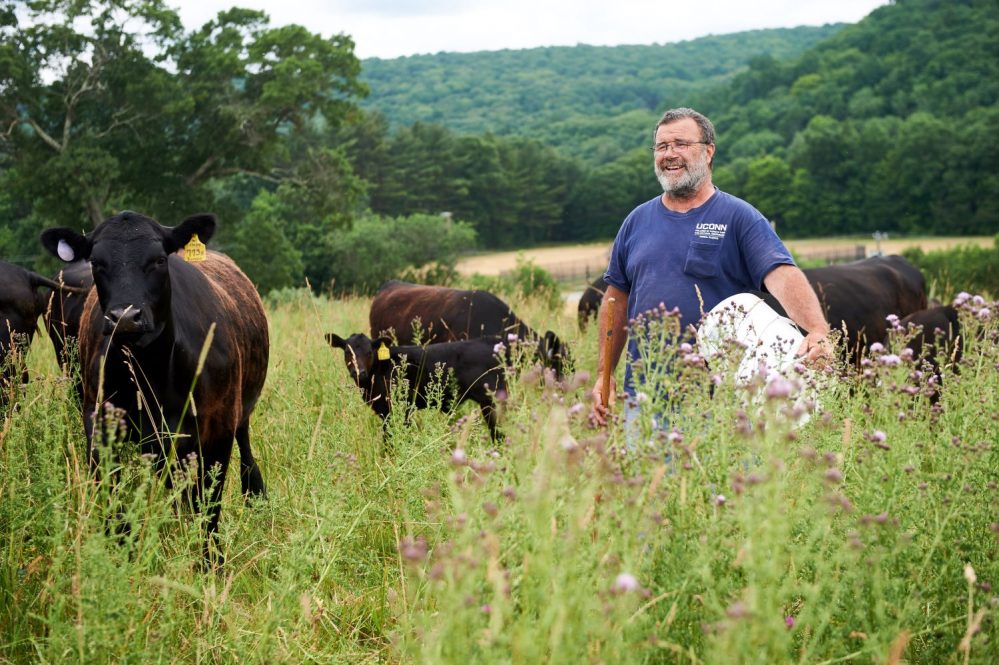A collaborative effort by researchers at the UConn College of Agriculture, Health and Natural Resources, Farm Credit East, and the Connecticut Farm Bureau produced comprehensive reports outlining the current labor situation in the state’s agricultural and green industries.
The reports were prepared by Rigoberto Lopez, professor in the Department of Agricultural and Resource Economics (ARE). Christopher Laughton, director of knowledge at Farm Credit East was co-author on the green industry report; and Luis Seoane, a Ph.D. student in ARE and Joan Nichols, director of the Connecticut Farm Bureau, collaborated on the agricultural industry labor report. The reports were created under the umbrella of the UConn Zwick Center for Food and Resource Policy.
Connecticut’s robust green industry includes greenhouses, plant nurseries, floriculture, and landscaping businesses. Agriculture in the state includes livestock, fruit and vegetable farming, seafood, dairy products, tobacco, and wineries.
Across these operations, the researchers identified a common issue: a lack of labor availability.
These sectors have trouble filling the positions they need to maintain and grow their operations across the country.
“The labor problem is universal across all of agriculture,” Nichols says. “And not just in Connecticut, I think it’s a national problem as well.”
The researchers say agricultural and green industries have long had trouble staffing their operations, but the problem has become more severe in the past decade or so.
Connecticut’s economic landscape presents additional challenges. Many other sectors, like retail, can offer entry-level workers much more comfortable working conditions and, often, higher pay than agriculture. On top of that, the costs of production and living are higher in Connecticut than other states.
“There’s so many outside opportunities for workers, we’re not in rural Kansas, so it’s extra difficult,” Lopez says.
In other words, potential employees have lots of options when choosing a place to work. The national unemployment rate is 3.4%, according to the most recent data from the U.S. Bureau of Labor Statistics, and there are approximately two job openings per every job seeker.
“Prospective employees can take their pick from multiple opportunities, typically,” Laughton says. “That means there are jobs out there that just aren’t going to get filled, beyond agriculture.”
One way many operations are looking to address these challenges is by turning to automation. Machines are an increasingly viable option to replace hard-to-come-by human labor in picking, packaging, and unloading products.
“Agriculture has not been exempted from what is happening in other industries where you have people being replaced by machines,” Lopez says. “That is the technical change that is happening and is probably a part of the future of agriculture in Connecticut and other places.”
While machinery has a high up-front cost, in the long-term, it is often cheaper than workers since machines are in production beyond a typical workday hours and don’t require the same benefits. But the researchers don’t believe there’s a risk of machines completely eliminating the need for a human workforce.
“It’s not an all-or-nothing type of thing,” Laughton says. “I think every farm operator in Connecticut is looking for ways to make their operations more efficient through the use of equipment and automation.”
These industries are also increasingly turning to smart agriculture practices which help them make better-informed choices about selectively using inputs like pesticides, fertilizer, and labor to reduce costs.
There’s a need for a highly specialized workforce as well. The researchers emphasize that it is not only low-skill positions that are going unfilled, but higher-level managerial positions too. The report includes a recommendation that these struggling industries make themselves more attractive to these job seekers.
“The days of just putting a help wanted sign out and getting a group of qualified workers at your doorstep are over, if that was ever the case,” Laughton says. “The industry, in a meaningful way, needs to step up and be more proactive about workforce development and trying to fill the pipeline of new workers by partnering with educational institutions.”
One way to do this is through improving and developing programs that create a pipeline from high schools and colleges to industries that require skilled labor, similar to what the Connecticut manufacturing industry has done.
These programs can include trade education and mentoring programs that provide funds to operators to work with prospective employees, as some examples offered in the report.
“Development of a skilled agricultural workforce begins by fostering an interest and awareness among the next generation showing that farming can be a viable career path,” says Agriculture Commissioner Bryan P. Hurlburt. “As this report outlines, we need to provide the technical training necessary to meet the advanced production methods being implemented in our agriculture sector.”
Lopez is now working with his colleagues Assistant Professor Cristina Connolly and Assistant Professor in Residence Emma Bojinova to complete a needs assessment evaluation to further understand the problems and priorities of Connecticut farmers. This assessment will hopefully lead to the development of need-based programs that will help labor and other challenges faced by farmers throughout the state.
The agricultural labor report was partially funded by the Richard DelFavero Fund for Agricultural and Resource Economics while the green industry report was partially funded by the Connecticut Nursery and Landscape Association.
This work relates to CAHNR’s Strategic Vision area focused on Ensuring a Vibrant and Sustainable Agricultural Industry and Food Supply.
Follow UConn CAHNR on social media



